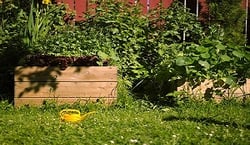Summer is a great time to enjoy your beautiful garden, unfortunately unwanted pests may also find your garden attractive. Building a fence will allow you to protect your investment and keep your garden safe. Here are two critical tips to keep pests out and your plants protected.
Choose the Right Fence Material
The type of fence you will want depends on which critters you are having trouble with. Are your garden visitors deer that want to nibble on your plants or are they something that flies or climbs, which means you will also need protection overhead.
Many types of fences will work for common visitors like deer, however a wood fence works best since they are attracted to what they can see, and your greenery looks tasty. The overpopulation of deer in many regions of the United States means less food available, so they have become very brave at entering yards looking for a meal. Your fence should be 8-10 feet tall to deter them from jumping in.
A chicken wire fence may be all you need if you are just having issues with cats or dogs. They will likely leave it alone just seeing the barrier. A finer mesh fence may be needed in instances where chipmunks and rabbits are your challenge. These animals are also able to dig under a fence, so burying that fine barrier at least a foot underground may be necessary.
Install Your Fence Posts Properly
Regardless of what type of fence you're installing, the positioning of your fence posts is the most important step. The fence posts provide your fence stability and allow it to last longer. Garden fence posts should be no more than 6 feet apart, so it can best support the fencing materials you are installing between the posts.
The Right Tools for the Job
When considering fence building to include attaching wire to wood posts, consider using the F46A 40-315 Fence Stapler offered by BECK. It’s durable yet lightweight compared to most fence staplers, includes an adjustable depth of drive, and is high-powered for hardwood applications. BECK also offers the cordless F70G Gas Fence Stapler for the fences that are farther out from your building power source. Want more fence construction advice? Download our whitepaper, 5 Important Tips for Building the Perfect Fence, by clicking the button below.
.svg.png)


